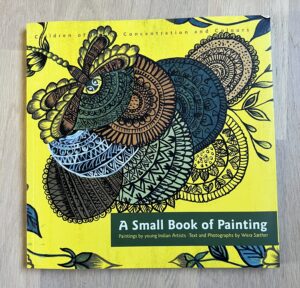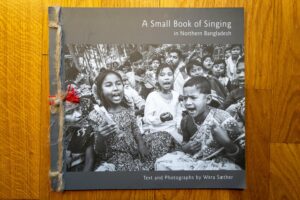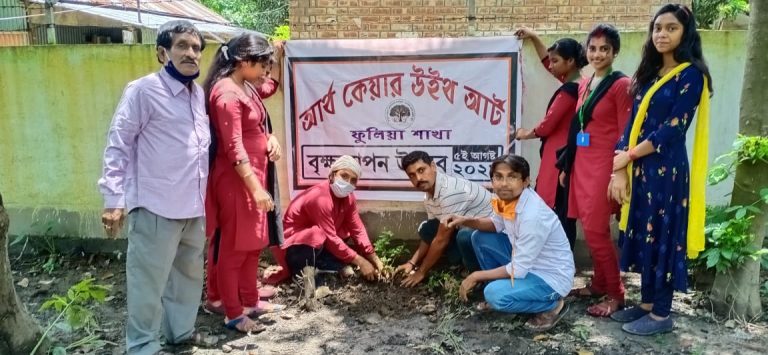Grasrotarbeid
For mer informasjon, se: www.ewa-norge.no
A Small Book Of Painting

How vibrantly strong and diverse colours are. The nuances of colours present us with a possibility of transformation. Grassroots art. Children´s art. Art with little money involved. Money is involved. Paper must be bought. The children need teachers who need to be paid. Our children painted before the pandemic, at home during the pandemic and do so now after the 2020-2021 pandemic, and will hopefully be doing so as new pandemics rise, along with the rising waters along the coastlines of Bengal.
A Small Book Of Singing

I am not a singer, nor am I a musician. I am not a Bengali. I am a European. A Norwegian who has been drawn into the rhythms and tunes of Bengal, east and west.
There is no way I can even want to abandon the place called Bengal – which is a geographical, existential, artistic and spiritual entity, though certainly fluid.
It is a place of frequent storms and floods. A place of – so far – limited disasters. «Limited disasters» may one day soon now become an ecological, social and financial emergency with millions of refugees, lost animals and drowned vegetation.
I am part of a collective and stubborn effort to preserve, strengthen and make known to outside people the profound value of traditional texts and tunes on this land. The texts and tunes are being taught to village children, girls and boys, Muslims and Hindus, Christians if Christians present themselves, in a northern region of Bangladesh.
This little book is about land, children, singing and playing local instruments. It is mainly a book of photographs.
You, the reader, are welcome into our grassroots effort.
You will see a few images of the land and its daily life, but first of all faces as they forget (about) themselves in the singing, with the rhythms, the tunes and the texts, some of which are old, and most often made by anonymous fakir and sadhu people.
No specific names of people or places are mentioned here.
«Grassroot Bengal» here, on this webpage, refers to my commitment to folk art, in tunes and colours, as taught to and practised by children and young people in the Bengali region. The teachers are local.
This commitment has a long history: it started with my hearing old spiritual and subversive Baul songs at a pilgrimage place called Kenduli, north of Kolkata, in 1992. My conclusion: ”This form of music must not vanish.”
In 1998, hearing very poor Muslim women singing similar songs on an island in Northern Bangladesh, my conclusion was the same: ”This music must mot vanish, and it is also mine.” But this singing will, of course, vanish if the deep feeling vanishes.
My question to myself, from 1998 onwards, has been how to nurture that deep feeling and help preserve the music. It had to be through the teaching of children. For that to happen, teachers and places were needed.
The wish to establish some sort of informal archive of what existed once upon a time co-existed, in me, with the main wish to preserve the music by having children learn it.
There is way to do it. It has got to be collective.
Supported by other Norwegians, in 2004 I began my grassroots efforts in support of the regional song traditions as taught to Muslim and Hindu children in Northern Bangladesh. This is work for peace, really. The fruits of those efforts remain, and they are many despite an unfortunate recent disruption of our efforts.
There is now a new beginning, a New Song, so to to speak, among musicians and young people in the same northern region, and this time I am more experienced – linguistically, mentally, and sociologically. I have known the musicians and master teachers since about 2009. They are still devoted to the work.
We need money to buy instruments. And we need to establish a basic financial support system for our hard-working teachers as well as for assistance to some of our young learners. In times of dire need, we may need more than this.
In Kolkata, a Trust called Earth-Care with Art has been established, with a house, Tori-Maa, in Tollygunje. The house was opened in March 2014. Tori means ”boat”.
Our artistic efforts in India have so far focused on painting and yoga, in weavers´ villages in Nadia and in our (slum) neighbourhood in Kolkata. The children are slowly learning to make their own pigments from berries, plants, fruit, coal.
There are strong connections and exchanges of experience and vision between the musicians/singers in northern Bangladesh and our devoted organizers and teachers in Kolkata and Nadia. The most devoted ones cross the border to learn and to teach. They may stay for weeks or even months.
This is one effort, east and west of the border, by people all speaking Bengali, with one goal: art, awareness about nature, and community – close to the Bay of Bengal and rising waters.
Small newsletters, photographs, and maybe some video clips will be shown on this webpage along the way. You are invited into ”the boat.”



























